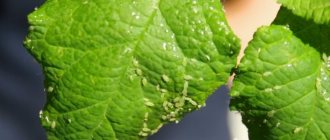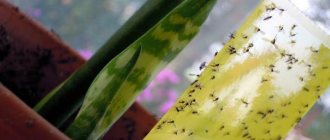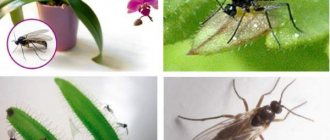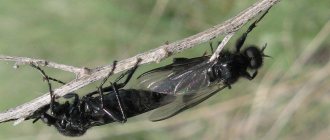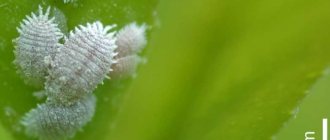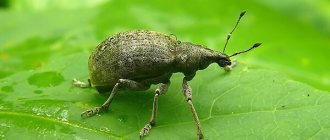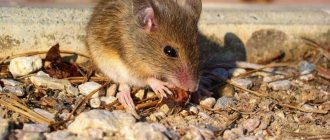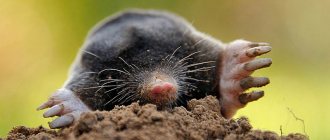Curling leaves, wilting buds, and the plant losing its attractiveness are the first signs of pests. To save the beauty on the windowsill, you need to know how to get rid of aphids on indoor flowers and prevent their appearance in the future. When fighting parasites, it is important to identify and eliminate the causes of the problem, and then destroy the pests using folk remedies or insecticides.
Aphids are a dangerous parasite that quickly adapts to any conditions and in a short time creates large colonies that destroy indoor plants. To save your home greenhouse, it is important to start pest control in a timely manner.
The article contains relevant and effective methods of combating aphids that will help save the plant and restore its attractiveness and vitality.
Description of aphids and how they appear in the house
Aphids are small insects with long legs and a pointed abdomen. The oblong body can be yellow, green, black or pink, but white pests are most often found on indoor plants.
One female aphid can lay up to 100 eggs at a time, which in a couple of weeks turn into adults that destroy flowers. Parasites use their proboscis to suck out the juice from the stems and leaves, depriving the plant of its vitality and attractiveness. In addition, they often spread viral and fungal diseases (sooty fungus). If the necessary measures are not taken in a timely manner, pests quickly adapt to any habitat and form numerous colonies that can destroy all the beauty on the windowsill.
Aphids attack different types of plants, but hyacinths, chrysanthemums, hibiscus, orchids, fuchsias and cyclamens are especially susceptible to attack by pests.
Where can pests appear in the house:
- through open windows and a balcony in the absence of mosquito nets;
- with new flowers (cut or in pots);
- from a person's clothing;
- through the soil used for transplantation;
- The carriers of the larvae can be ants that breed aphids for their own food.
To avoid the spread of aphids from a newly purchased plant to your home ones, keep it in quarantine for several days, and also carry out preventive treatment with special insecticides.
The main reason for the appearance of aphids is dried soil and high indoor temperatures.
External manifestations of the lesion
You can understand that aphids are on your orchid visually by looking at the appearance of the flower:
- The bud curls and does not look very beautiful, and subsequently falls off;
- Leaves and stems are limp and soft.
At an earlier stage of infection, you may notice a plaque that is slightly sticky when touched.
It is best if the flower is regularly inspected , then the presence of aphids can be noticed at an early stage; small insects will be visible on the back of the plant leaf.
When aphids appear on an orchid, the leaves become soft and limp.
Aphids use orchid sap for their nutrition, which causes serious damage to the plant. From the effects of aphids :
- Leaves curl;
- The stems become dark;
- And the flower stalks dry up.
Signs of pests on flowers
Aphids can cause significant damage to plants, so it is important to begin combating the parasites as early as possible. To do this, you need to know the signs of pests in your home greenhouse and periodically inspect each indoor flower for symptoms of disease.
The first manifestations of aphid infestation:
- a sticky layer and tiny punctures appear on the leaves and young shoots;
- flower buds quickly fade and fall off before they have time to bloom;
- the flower loses its attractiveness, withers and dries out;
- leaves darken and curl;
- Ants appear on the windowsill, attracted by the waste products of aphids, which are used by insects as food.
One of the signs of plant infestation by aphids is the appearance of ants. Insects feed on honeydew secreted by parasites, so they are always close to them and can even independently introduce pests to flowers
Preventive measures
If aphids have not overtaken you, you should not ignore prevention. To do this, constantly check your plants for aphids. Pay attention to the ants. If ants have appeared, then perhaps small pests have already settled on one of your plants.
Always cut off yellowed and dried leaves and ventilate the room daily. Keep the flowers warm, because in the cold they will not be able to fully develop, much less fight aphids.
Folk remedies and methods of combating aphids
You can remove aphids from indoor plants yourself using available means. Such methods are easy to use, affordable and absolutely safe for healthy flora, people and pets.
Algorithm for saving indoor plants:
- Isolation of a sick flower, which will protect the rest from infection.
- Preventive spraying of healthy flora.
- Treatment of the affected flower using the chosen method.
Folk remedies for fighting aphids are presented in the table:
| Active substance | Procedure for preparing the composition | Mode of application |
| Celandine | Grind 150 g of dried raw materials or 350 g of fresh herbs and add 1 liter of water. Leave the product in the dark for 24 hours | Spray the plant with the resulting infusion three times at intervals of a day. |
| Wood ash | Mix 50 g of soap, 0.5 l of ash and 10 l of water | Treat the affected leaves and shoots with a filtered solution until the pests are completely destroyed. |
| Garlic | Grind 30 g of garlic in a blender, add 1 liter of water and leave to brew for a day in a dark place. | Treat the flowers with the resulting product three times at intervals of 5 days. |
| Tomato tops | Grind 500 g of raw material, add 1 liter of water and boil for 30 minutes. Add 4 g of liquid soap to the cooled broth | Treat the affected plant until complete recovery. |
| Tobacco | Combine raw materials and water in a 1:2 ratio and let it brew for 2 days. | Dilute the resulting infusion with water and spray the flower. Avoid contact with the soil to avoid damage to the root system. |
| Hot pepper | Grind 50 g of pepper and add 125 ml of water. Boil the mixture for an hour and let it brew for a day | Dilute the filtered infusion in 10 liters of water, use for spraying and watering flowers |
| Orange peels | Pour 100 g of citrus peel with water and let it brew for a couple of days in a warm place | Spray plants affected by aphids |
| Needles | Pour 500 g of pine needles into 2 liters of water and leave for a week, then strain and dilute with water in a ratio of 1:7 | Treat the flower several times with a break of 4 days |
Geranium, dill, parsley, mint or marigold will help fight aphids. Parasites cannot stand the aromas of these plants, so by placing a pot with one of them on the windowsill, you can not only get rid of pests, but also avoid their appearance in the future.
Ladybugs can be used as a biological method of controlling aphids, so do not drive out an insect that has settled on an indoor flower
What kind of insect is this and why is it dangerous?
White aphids are easy to recognize if they have settled on an ornamental plant. It has a teardrop-shaped light body, reaching a length of 0.5 cm. The oral apparatus is represented by a proboscis. There are antennae on the head that act as sensors.
Externally, the body shape is drop-shaped. If you look at an individual under a microscope, you can see that its mouthparts consist of a proboscis - with which the aphid pierces the surface of plants (shoots or leaves). The head is equipped with long antennae - it is on them that tactile sensors are located.
There are individuals with and without wings. Winged aphids reproduce asexually. Scientists believe that the appearance of wings in insects is due to the fact that in the process of evolution they were forced to escape from ladybugs and ground beetles. Wingless aphids change several hosts during their life. They are born bisexual, mate, lay eggs, and after 7-14 days new offspring emerge from them.
You can read about other types of insects and their characteristics here.
Next you can see what the pest looks like.
Mechanical methods of getting rid of pests
You can save indoor flowers using mechanical cleaning, but this method is effective only at the initial stage of infection. To preserve the plant, remove damaged leaves, buds and shoots and wash it daily under running water. A solution of laundry soap will help to achieve maximum effect. Processing procedure:
- Prepare a soap solution from laundry soap and water in a ratio of 1:6.
- Prepare the necessary attributes, put on rubber gloves.
- Soak a sponge in the solution and thoroughly wipe all leaves, shoots and stems. Avoid getting the product on the soil.
- Rinse the plant with clean running water.
- Repeat the treatment daily until the parasites are completely eliminated.
To mechanically remove aphids, wipe the leaves daily with a damp sponge, remove affected shoots and bathe the flowers under running water.
As an alternative to soap solution, you can use medical alcohol - dissolve 6 tbsp in 1 liter of water. spoons of the product and wipe all the leaves. This composition effectively removes pests and does not damage the leaves, since ammonia quickly evaporates from the surface.
To be sure to get rid of aphids, replace the top part of the soil, where eggs and larvae of pests may be. In this case, choose high-quality soil that has been disinfected or frozen.
Chemicals for killing parasites
If folk remedies are ineffective, use chemicals. The choice of means depends on the degree of damage and the scale of the disaster. The most effective means include: “Decis”, “Iskra”, “Fitoverm”, “Aktellik”, “Confidor”, “Akarin”, “Karate”.
Spraying flowers with chemicals will help get rid of aphids. When working with insecticides, observe safety precautions and strictly follow the instructions for the product.
Procedure for using chemicals:
- Read the instructions for use of the product.
- Take the recommended safety measures - put on seals and a respirator, remove pets and children from the premises. After handling, wash your hands thoroughly with a concentrated soap solution.
- Wipe the leaves and stems with a sponge soaked in soapy water and then let dry.
- Spray the flower. Carry out the treatment on the balcony on a cloudy day at a temperature of +21…25 ℃, since at a lower temperature the effectiveness of the drug decreases.
- Perform preventive spraying of all plants in the house to prevent aphids from moving onto them.
- Re-treat the flowers several times at intervals of 5-7 days (depending on the recommendations in the instructions).
If the plant cannot be saved, discard it to avoid contaminating other flowers.
Prevention of aphids
Proper plant care and compliance with the recommended preventive measures will help to avoid the appearance of aphids:
- periodically carry out preventive treatment of plants;
- Make sure to maintain the optimal temperature in the house, as insects settle in a stuffy, poorly ventilated room;
- keep new flowers in quarantine;
- install mosquito nets on all windows in the apartment;
- do not place bouquets of cut flowers (especially chrysanthemums and roses) near indoor plants;
- Soak the new soil for replanting in the cold for several days to destroy the larvae and eggs of pests.
To preserve indoor flowers, provide them with proper care, regularly inspect them to identify pests in a timely manner, and periodically carry out preventive treatment
Maintaining a favorable microclimate in the house, proper care of plants and compliance with preventive measures will help save indoor flowers from aphids. If you were unable to protect them from pests, start fighting when parasites are first detected, preventing the colony from growing. Mechanical treatment, folk remedies and chemicals can help in exterminating insects. The choice of control method depends on the scale of the disaster and individual preferences.
